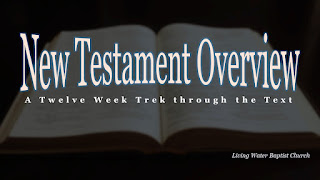SERMON: New Testament Overview, Part 1: The New Testament
New Testament Overview
Part 1: The New Testament
- I. Introduction
- This Session:
- Background to the Gospels and Acts
- Overview of the New Testament
- II. Background to the Gospels and Acts
- For the last session of the OT Overview, we considered the Intertestamental Period
- Roughly 400 BC – 4 BC
- This moves from Persian dominance through Hellenization (“Greeking”) into the Roman period.
- Hellenization brought about language changes
- When Daniel was written, Aramaic was the lingua franca
- Alexander the Great normalized a “common” (Koine) Greek among his troops and all the lands he conquered.
- Because of this, the Jews translated the OT in Greek (The Septuagint [LXX], c. 250-125 B.C.)
- By the time of New Testament, Greek had major dominance (Latin was restricted to Rome)
- There are intersections of Greek philosophy in the first century mind that the writers of Scripture address (Acts & Epistles)
- The Roman Empire enacted many changes, like rulers
- The Rise of Antipater and his Sons (63-37 B.C.) Roman supporters of Edomite descent (Idumaean), founded the Herodian dynasty
- The Reign of Herod the Great (37-4 B.C.) King of Judea, slaughtered babies in Bethlehem
- The Rule of Herod’s Sons (like Herod Antipas) and Grandson, Herod Agrippa I (4 B.C.-A.D. 44)
- The Rule of Roman Governors (A.D. 6 onward) (E.g., Pontius Pilate from 26/27 to 36/37 AD)
- Many books became popular in this time, many of which with a messianic emphasis
- The Apocrypha, which was not officially recognized as Scripture by anyone (Jew or Gentile) until the RCC made it canonical in response to the Reformation. It contains some helpful history but also dubious and false accounts.
- The Pseudepigrapha (false writings), those books falsely claiming to be written by biblical authors (e.g., Enoch I and The Testament of Abraham)
- Rise of divergent groups:
- The aristocratic elders
- The religious establishment:
- “Chief priests, priests, scribes” — many are the Sadducees
- Pharisees (more conservative group)
- Others: Essenes, Zealots
- In the dispersion (diaspora)
- The Hebraists (those who abstained from forms of Hellenization)
- The Hellenists (note those Jews with Greek names)
- The Proselytes (Gentile converts to Judaism)
- The God-fearers (Gentile worshippers who haven’t converted)
- New place of worship:
- Temple (renovated by Herod)
- The synagogues, which became prominent in the exile and post-exile, now a part of Jewish daily life.
- Beliefs:
- The One True God – Monotheism
- God’s Choice of Israel – Election
- God’s Provision of a Way to Live – The Torah, God’s Wisdom
- The Hope for the Future
- The Restoration of Israel
- The Conversion, Subjugation, or Destruction of the Gentiles
- A Purified Temple
- A Purified Worship
- The Coming of the Messiah
- III. Overview of the New Testament
- Written within one century
- History: Gospels & Acts
- Pauline Epistles: Romans—Philemon
- We can break this down further (e.g., the pastoral epistles: 1 Timothy — Titus)
- General Epistles: Hebrews—Jude
- Prophetic: Revelation
- What should be there?
- Several factors brought about the New Testament canon:
- Spurious writings and attacks on genuine writings
- The content of the New Testament writings testified of their own authenticity, and were naturally collected
- Apostolic writings were already being used in worship
- Ultimately, and edict by Diocletian in AD 303 demanding all sacred books to be burned resulted in the New Testament collection.
- Apostolic recognition:
- Paul, for example, recognized Luke’s writing on a par with the OT (1 Tim. 5:18 quotes Deut. 25:4 and Luke 10:7, noting both texts as “the Scripture says”).
- Peter also recognized Paul’s writings as Scripture (2 Peter 3:15–16).
- Letters were being read in the churches and even circulated among the church (cf. Col. 4:16; 1 Thess. 5:27).
- Post-Apostolic Recognition:
- Clement of Rome (c. AD 95) mentioned at least eight New Testament books in a letter;
- Ignatius of Antioch (c. AD 115) also acknowledged about seven books;
- Polycarp, a disciple of John, (c. AD 108), acknowledged fifteen letters. (These are only what these men mentioned.)
- The Muratorian Canon (AD 170) included all the NT books except Hebrews, James, and one epistle of John.
- Athanasius in AD 367 cited the 27 books of the NT
- In AD 363, the Council of Laodicea stated that only the OT and 27 books of the NT were to be read in the churches.
- The Council of Hippo (AD 393) recognized the 27 books,
- the Council of Carthage (AD 397) affirmed that only those canonical books were to be read in the churches.
- How did the church recognize which books were canonical?
- Apostolicity. Was the author an apostle or did he have a connection with an apostle? (E.g., Mark wrote under Peter’s authority, and Luke wrote under Paul’s authority).
- Acceptance. Was the book accepted by the church at large?
- Content. Did the book reflect consistency of doctrine with what had been accepted as orthodox teaching?
- Inspiration. Did the book reflect the quality of inspiration? The book should bear evidence of high moral and spiritual values that would reflect a work of the Holy Spirit.
- IV. Conclusion
- Next Time:
- The Four Gospels & Jesus Christ
